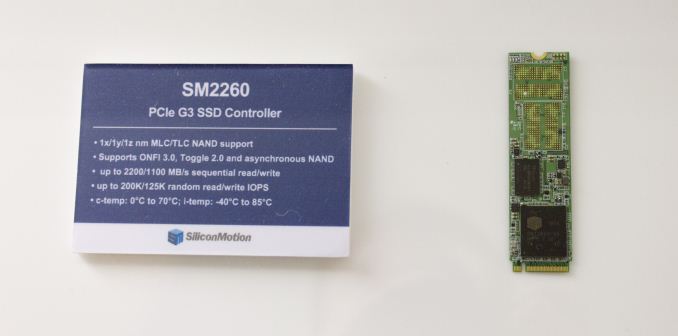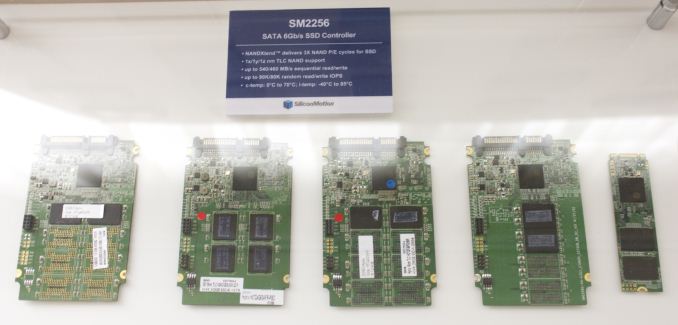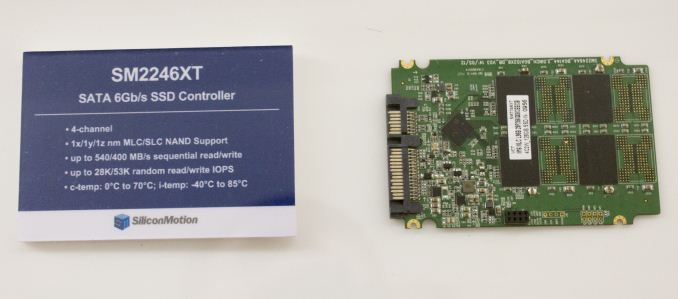Silicon Motion Displays Upcoming SM2260 PCIe 3.0 x4 NVMe Controller
by Kristian Vättö on June 9, 2015 1:10 PM EST- Posted in
- Storage
- SSDs
- PCIe SSD
- TLC
- NVMe
- Silicon Motion
- Computex 2015
- SM2256
- SM2260

Silicon Motion has remained relatively quiet about its plans for a PCIe controller. We have known that the company is working on one (well, it would be a major surprise if it wasn't), but until last week Silicon Motion had not shared any details. The controller is called SM2260 and it's a PCIe 3.0 x4 design with support for NVMe. Both MLC and TLC NAND are supported at lithographies as small as 15nm, which suggests the use of LDPC error correction similar to the company's SM2256 controller. Preliminary performance specs come in at up to 2.2GB/s sequential read and 200K random read IOPS, but I wouldn't be surprised to see these change before the final product ships.
Silicon Motion is still fairly early in development and the SM2260 won't be available until sometime next year. For now the company is keeping the additional details close to its chest, but we'll hear more once Silicon Motion has something concrete to show.
In addition to the SM2260, Silicon Motion showcased its new SM2256 controller that will be shipping in the next couple of months. It's the first commercially available controller & firmware solution with TLC support and as a part of Computex Silicon Motion announced that it now supports Micron's 16nm TLC NAND as well, along with all other available TLC NAND dies. ADATA already displayed its SP550 with the SM2256 inside and it will be among the first drives to ship with the new SMI controller. We have some preliminary benchmarks of a 500GB SM2256 reference design sample in our Bench section, so head there if you're interested in taking an early look.
Another product Silicon Motion had on display was the SM2246XT, which is a DRAM-less version of the popular SM2246EN. There is a slight performance impact from the lack of DRAM cache as only parts of the NAND mapping table can be stored in the controller's internal SRAM cache, but in return the SM2246XT offers lower cost due to a smaller die (no need for DRAM controller). Obviously the drive requires no separate DRAM either, which further reduces the cost for the assembler of the drive. SM2246XT is already used by SanDisk in the SSD PLUS and Z400s that was released a couple of weeks ago. I believe we will see the low-end market shift more towards DRAM-less designs in the next year as the race to the bottom gets tougher and with more sophisticated controllers it's possible to have decent performance even without the DRAM cache. Currently Silicon Motion has no plans for an XT version of the SM2256, although I would personally see TLC NAND and DRAM-less controller as the ultimate value play.












11 Comments
View All Comments
dragantoe - Tuesday, June 9, 2015 - link
honestly i can't get excited for nvme unless we get 240 gb for ~$60 AT LEASTdragantoe - Tuesday, June 9, 2015 - link
i meant at mostahtoh - Tuesday, June 9, 2015 - link
I'm not getting excited for hardware at allit is just tools
Thud2 - Saturday, June 13, 2015 - link
Why are you here then? This is a PC hardware site.fokka - Tuesday, June 9, 2015 - link
so you want fast as fuck and cheap as fuck. i guess you'll have to wait a little longer.Gigaplex - Tuesday, June 9, 2015 - link
So you'd turn your nose up at 240GB of NVMe SSD at $70? You're hard to please.euler007 - Wednesday, June 10, 2015 - link
The cheapest Samsung drive on newegg right now at 250GB is 99$. So basically, you want 4-5 times the peak performance at a 40% discount. Must be nice negotiating with you.Einy0 - Tuesday, June 9, 2015 - link
I'm happy to see more controllers that support NVMe but the final paragraph kind of took the wind out of my sails. While I obviously want to see cheaper SSDs, I'd hate to see that at the cost of stability and performance. Storing only the mapping tables that can be fit in the controller's SRAM cache seems very limiting. It's not like these are full blown server CPUs with 32MB of cache. Would it not be more reasonable to integrate a smaller DRAM cache in PoP? Perhaps eDRAM has made some strides in recent years? A controller with 64 to 256MB of eDRAM on the same die?DanNeely - Tuesday, June 9, 2015 - link
If it was talking about mid/high range parts I'd agree; but that's a race to the bottom design. An area where saving 2 cents is more important than a even a 2x performance penalty; which is why race to the bottom laptops still mostly have HDDs. Even a crappy SSD is faster than an HDD; anything to help transition WorstBuy special laptops to the future is a net win.canthearu - Tuesday, June 9, 2015 - link
I'd be very concerned about the retention of TLC NAND at 16nm.Samsung had trouble with their evo drives using TLC 19nm NAND, I can't imagine how bad it would be at 16nm.